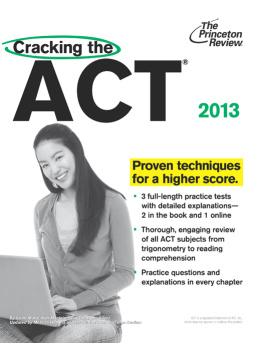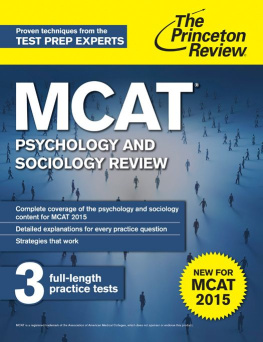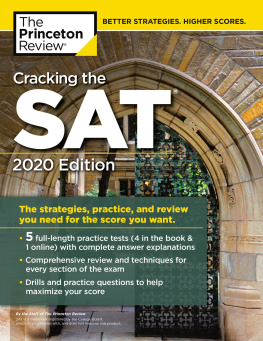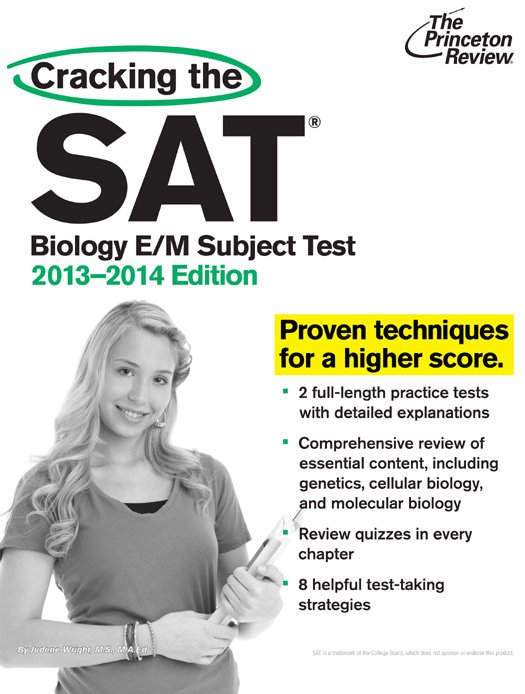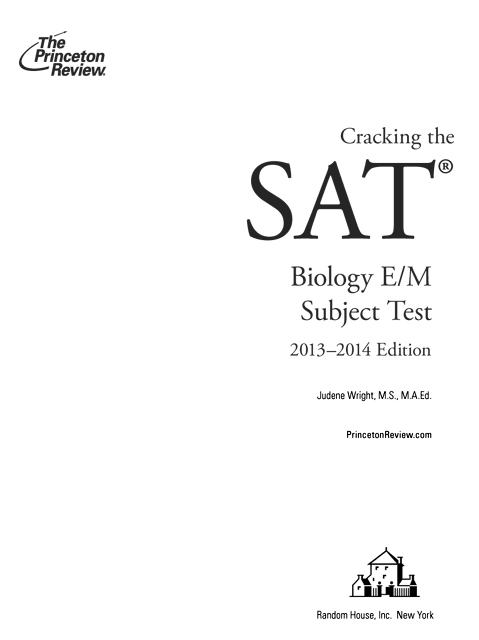
Editorial
Rob Franek, Senior VP, Publisher
Mary Beth Garrick, Director of Production
Selena Coppock, Senior Editor
Calvin Cato, Editor
Kristen Otoole, Editor
Meave Shelton, Editor
Random House Publishing Team
Tom Russell, Publisher
Nicole Benhabib, Publishing Director
Ellen L. Reed, Production Manager
Alison Stoltzfus, Managing Editor
The Princeton Review, Inc.
111 Speen Street, Suite 550
Framingham, MA 01701
E-mail:
Copyright 2013 by TPR Education IP Holdings, LLC.
Cover art Jonathan Pozniak.
All rights reserved. Published in the United States by Random House, Inc., New York, and simultaneously in Canada by Random House of Canada Limited, Toronto.
The Princeton Review is not affiliated with Princeton University.
eBook ISBN: 978-0-307-94572-3
Trade Paperback ISBN: 978-0-307-94552-5
SAT Subject Test is a registered trademark of the College Board, which does not sponsor or endorse this product.
Editor: Selena Coppock
Production Editor: Harmony Quiroz
Production Coordinators: Deborah A. Silvestrini and Todd Cubbison
v3.1
Acknowledgments
I dedicate this book to my children, James, Nicholas, Ian, and Rose, for redefining my role as a teacher; and to my parents, Richard and Barbara Lewandowski, for giving me the faith to believe that I can do whatever I set out to do. I love you all.
Thanks to Paul Kanarek for more help than I can list here, and thank you to Christi Pope, Sarah Woodruff, and Dustin Yoon for their editing suggestions and help.
Special thanks to Adam Robinson, who conceived of and perfected the Joe Bloggs approach to standardized tests and many of the other successful techniques used by The Princeton Review.
Thank you to Caren Gough for her thorough content review for the 20132014
edition of this book.
Contents
Chapter 1
Introduction
WHAT ARE THE SAT SUBJECT TESTS?
They are a series of one-hour exams administered by Educational Testing Service (ETS). Unlike the SAT, the SAT Subject Tests are designed to measure specific knowledge in specific areas. There are many different tests in many different subject areas, such as biology, history, French, and math. They are scored separately on a 200800 scale.
HOW ARE THE SAT SUBJECT TESTS USED BY COLLEGE ADMISSIONS?
Because the tests are given in specific areas, colleges use them as another piece of admissions information and, often, to decide whether an applicant can be exempted from college requirements. For example, a certain score may excuse you from a basic English class or a foreign language requirement.
SHOULD I TAKE THE SAT SUBJECT TESTS? HOW MANY? WHEN?
About one-third of the colleges that require SAT I scores also require that you take two or three SAT Subject Tests. Your first order of business is to start reading those college catalogs. College guidebooks, admissions offices, and guidance counselors should have this information as well.
As to which tests you should take, the answer is simple:
1. Take those Subject Tests that you will do well on.
2. Take the tests that the colleges you are applying to may require you to take.
The best possible situation, of course, is when the two match.
Some colleges have specific requirements, others do not. Again, start asking questions before you start taking tests. Once you find out which tests are required, if any, part of your decision making is done. The next step is to find out which of the tests will show your particular strengths and to contact colleges to see which tests they suggest or require. Evaluate your own strengths and skills. Possibilities range from English literature, U.S. or world history, biology, chemistry, and physics to a variety of foreign languages.
As for when, take tests that are as close as possible to the corresponding coursework you may be doing. If you plan to take the SAT Chemistry Test, for example, and you are currently taking chemistry in high school, dont postpone the test until next year.
WHEN ARE THE SAT SUBJECT TESTS OFFERED?
In general, you can take from one to three Subject Tests per test date in October, November, December, January, May, and June at test sites across the country. Not all subjects are offered at each administration, so check the dates carefully.
HOW DO I REGISTER FOR THE TESTS?
You can register at the College Board website at www.collegeboard.com. This site contains other useful information such as the test dates and fees. If you have questions, you can talk to a representative at the College Board by calling 866-630-9305.
You may have your scores sent to you, to your school, and to four colleges of your choice. Additional score reports will be sent to additional colleges for, you guessed it, additional money. The scores take about five weeks to arrive.
A Couple of Words About Score Choice
As of February 2009, you can choose which SAT Subject Test scores you want colleges to see. This is great news! For one thing, if you take more than one SAT Subject Test on a given date, youll be able to choose which tests from that date youd like to submit to colleges. So if, for example, you take the Biology M test followed by the French test, but you dont think that the French test went very well, you can simply opt out of having that French scores sent to your schools.
This score reporting policy is optional for students. This means that you arent required to opt in and actively choose which specific scores you would like sent to colleges. If you decide not to use the Score Choice reporting feature, then all of the scores on file will automatically be sent when you request score reports.
For more information about this score-reporting policy, go to the College board website at www.sat.collegeboard.org/home.
WHATS A GOOD SCORE?
Thats hard to say, exactly. A good score is one that falls within the range of scores the college of your choice usually accepts or looks for. However, if your score falls below the normal score range for Podunk University, that doesnt mean you wont get into Podunk University. Schools are usually fairly flexible in what they are willing to look at as a good score for a certain student.
Along with your score, you will also receive a percentile rank. That number tells you how you fit in with the other test takers. In other words, a percentile rank of 60 means that 40 percent of the test takers scored above you and 60 percent scored below you.
WHAT IS THE PRINCETON REVIEW?
The Princeton Review is a test-preparation company based in New York City. We have branches across the country and abroad. Weve developed the techniques youll find in our books, courses, and online resources by analyzing actual exams and testing their effectiveness with our students. What makes our techniques unique is our approach. We base our principles on the same ones used by the people who write the tests. We dont want you to waste your time with superfluous information; well give you just the information youll need to get great score improvements. Youll learn to recognize and comprehend the relatively small amount of information thats actually tested. Youll also learn to avoid common traps, to think like the test writers, to find answers to questions youre unsure of, and to budget your time effectively.




